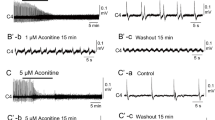Abstract
1. The excitability of inspiratory and expiratory neurones in the medulla oblongata was measured by means of their facility to be invaded antidromically. Their antidromic excitability was found to be greatest during periods of spontaneous discharging, less immediately before, and least immediately after such discharge period.
2. The antidromic excitability of the tested inspiratory neurones was markedly increased during hyperventilation apnoea, compared with that during the pause between two spontaneous respiratory discharge periods.
3. It is possible to trigger additional antidromic discharges even in the respiratory pauses by augmenting the stimulation voltage applied to the descending respiratory pathway. This may be explained by facilitating synaptic interconnections between the respiratory neurones.
4. Antidromic stimulation of expiratory neurones brings about transient inhibition of inspiratory neurones. This finding may best be explained by reciprocal innervation of inspiratory and expiratory neurones by axon collaterals.
5. Action potentials from medullary respiratory nerve cells tended easily to disintegrate into their “A” and “B” fractions when antidromic tetanization was applied. They also showed prolongation of their latencies and a tendency for periodic following and failing to follow the antidromic stimuli.
Zusammenfassung
1. Die Erregbarkeit inspiratorischer und exspiratorischer Neurone der Medulla oblongata ist, gemessen an ihrer antidromen Invasionsbereitschaft, am größten während der spontanen Entladungsperioden, weniger groß unmittelbar vor und am kleinsten nach den Entladungsperioden.
2. Während der Hyperventilationsapnoe ist die Erregbarkeit an den von uns geprüften inspiratorischen Neuronen deutlich größer als während der Atempause zwischen zwei spontanen respiratorischen Entladungsperioden.
3. Durch Erhöhung der Reizstärke an den absteigenden Atmungsbahnen im Rückenmark gelingt es, zusätzliche antidrome Entladungen auch in den Atempausen auszulösen. Dies kann durch fördernde synaptische Querverbindungen zwischen den Atmungsneuronen erklärt werden.
4. Antidrome Reizung exspiratorischer Neurone führt zu kurzfristiger Hemmung der inspiratorischen Neurone. Dieser Befund wird mit der reziproken Innervation inspiratorischer und exspiratorischer Neurone über Axonkollateralen erklärt.
5. Bei antidromer Reizung mit frequenten Impulsen, sowie auch bei niederfrequenter Reizung in den Intervallen zwischen den spontanen Entladungsperioden tendieren respiratorische Zell-Aktionspotentiale besonders leicht zur „Disintegration“, Latenzzeitverlängerung und periodischer Gruppenbildung.
Similar content being viewed by others
Literatur
Baumgarten, R. von, K. Balthasar u. H. P. Koepchen: Über ein Substrat atmungsrhythmischer Erregungsbildung im Rautenhirn der Katze. Pflügers Arch. ges. Physiol. 270, 504–528 (1960).
—— u. K. P. Schäfer: Beitrag zur Lokalisationsfrage bulboreticulärer respiratorischer Neurone der Katze. Pflügers Arch. ges. Physiol. 264, 217–227 (1957).
——, and E. Kanzow: The interaction of two types of inspiratory neurons in the region of the tractus solitarius of the cat. Arch. ital. Biol. 96, 361–373 (1958).
——, and N. Dodich: Microelectrode studies of phrenic motoneurons. Ann. N.Y. Acad. Sci. 109, 536–544 (1963).
Breckenridge, A. J., H. E. Hoff, and H. T. Smith: Effect on respiration in midpontine animal of chemical inhibition of facilitatory system. Amer. J. Physiol. 162, 74–79 (1950).
Brock, L. G., J. S. Coombs, and J. C. Eccles: Intracellular recording from antidromically activated motoneurones. J. Physiol. (Lond.) 122, 429–461 (1953).
Burns, B. D., and G. C. Salmoiraghi: Repetitive firing of respiratory neurones during their burst activity. J. Neurophysiol. 23, 27–46 (1960).
Chalazonitis, N.: Effects of changes in pCO2 and PO2 on rhythmic potentials from giant neurons. Ann. N.Y. Acad. Sci. 109, 451–479 (1963).
Eccles, J. C.: The central action of antidromic impulses in motor nerve fibres. Pflügers Arch. ges. Physiol. 260, 385–415 (1955).
Foa, C.: Nuova richerche sull'apnea e sull automatismo del centro respiratorio. Arch. Fisiol. 9, 453 (1911).
Fuortes, M. G. F., K. Frank, and M. C. Becker: Steps in the production of motoneuron spikes. J. gen. Physiol. 40, 735–752 (1957).
Haldane, J. S., and J. G. Priestley: Regulation of the lung-ventilation. J. Physiol. (Lond.) 32, 225–266 (1905).
Hodgkin, A. L., and A. F. Huxley: The dual effect of membrane potential on sodium conductance in the giant axon of Loligo. J. Physiol. (Lond.) 116, 497–506 (1952).
Lloyd, D. P. C.: The interaction of antidromic and orthodromic volleys in a segmental spinal motor nucleus. J. Neurophysiol. 6, 143–151 (1943).
Lumsden, T.: Observations on the respiratory centers. J. Physiol. (Lond.) 57, 153–160 (1923).
Meyer-Wegener, H.: Über die Hyperventilationsapnoe des Menschen. Pflügers Arch. ges. Physiol. 269, 570–579 (1959).
Nakayama, S., u. R. von Baumgarten: Lokalisierung absteigender Atmungsbahnen im Rückenmark der Katze mittels antidromer Reizung. Pflügers Arch. ges. Physiol. 281, 231–244 (1964).
Phillips, C. G.: Actions of antidromic pyramidal volleys on single Betz cells in the cat. quart. J. exp. Physiol. 44, 1–25 (1959).
——, and G. M. Shepherd: Responses of mitral cells to stimulation of the lateral olfactory tract in the rabbit. J. Physiol. (Lond.) 168, 65–88 (1963).
Pitts, R. F., H. W. Magoun, and R. W. Ranson: Localisation of the respiratory centers in the cat. Interrelation of the respiratory centers in the cat. Amer. J. Physiol. 126, 673–688 (1939).
Suzuki, H., and Y. Tukuhara: Recurrent inhibition of the Betz cell. Jap. J. Physiol. 13, 386–398 (1963).
Verworn, H., and A. B. Otis: Continuous analysis of alveolar gas composition during work, hyperpnea, hyperapnea and anoxie. J. appl. Physiol. 1, 717–724 (1949).
Wilson, V. J.: Recurrent facilitation of spinal reflexes. J. gen. Physiol. 42, 703–713 (1959).
Author information
Authors and Affiliations
Additional information
Mit 8 Textabbildungen
Mit Unterstützung der Deutschen Forschungsgemeinschaft und der Göttinger Akademie der Wissenschaften.
Rights and permissions
About this article
Cite this article
von Baumgarten, R., Nakayama, S. Spontane und reizbedingte Änderungen der antidromen Erregbarkeit von bulbären respiratorischen Nervenzellen der Katze. Pflügers Archiv 281, 245–258 (1964). https://doi.org/10.1007/BF00412425
Received:
Issue Date:
DOI: https://doi.org/10.1007/BF00412425



